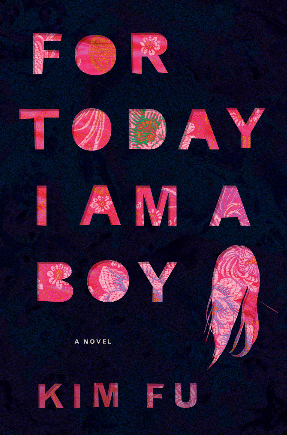For Today I Am a Boy
by Kim Fu
reviewed by A. Naomi Jackson
Transgender icon Laverne Cox of Orange is the New Black fame has been touring the country with her “Ain’t I a Woman” speech, injecting new life into Sojourner Truth’s question and suggesting that the struggle for the civil and human rights of transgender Americans is the issue of our time. In an interview with Time, Cox states that, “When people have points of reference that are humanizing, that demystifies difference.” Literature has the power to change minds and lives by offering these points of reference. Janet Mock’s memoir, Redefining Realness, covers important ground with its narrative of Mock’s experiences as an openly transgender women, activist, and journalist. Jackie Kay’s 2013 novel, Trumpet, told the story of transgender jazz musician Billy Tipton from the perspective of Tipton’s wife and son. Kim Fu’s novel, For Today I Am a Boy, is a significant contribution to this growing body of literature, allowing readers an up-close, unflinching portrait of a person whose gender identity is different from the gender assigned to them at birth.
For Today I Am A Boy tells the story of a boy who wants to grow up to be a girl. Peter Huang is born to Chinese immigrants in a nondescript town in Ontario. From an early age, Peter yearns to be like his three sisters and the novel follows his journey towards that dream. Along the way, Huang moves to Montreal where he works as a cook. Fu puts Huang squarely in the macho world of restaurant kitchens, a skillful decision that forces Peter to squarely confront his masculinity. Peter tries two failed relationships—the first with a domineering white woman, the second with a woman who lures Peter into the dark world of curative Christian ministry. Fu renders Peter’s attempts to “fix” himself with care and empathy, showing the solace of religious conviction and the beauty of confession, as well as religion’s ultimate failure to relieve us of who we are.
For Today I Am A Boy is as much a novel about sisterhood as it is about transgender identity. Peter’s three sisters, Helen, Adele, and Bonnie, each offer him a different version of womanhood: one focuses on obeying the rules, another on following wanderlust and the impulses of your heart, and the last on using your body to make a way for yourself in the world. One of the most moving scenes in the novel sees Peter drive cross-country with his sisters’ clothes in a van, detouring from a scheduled thrift shop appointment to his apartment in Montreal, where he breaks up the monotony of his work life by dressing up as a woman, literally trying on his new identity in private.
There is a beautiful moment when Peter, just home with his first pair of women’s shoes, realizes that they are not enough to make him who he wants to be, “And I still could not pin down what would be enough, other than resetting time, going back to before my birth, before my conception, and finding a way to choose.” Fu’s steadfastness in portraying Peter’s painful, hermetic life is admirable, as is her focus not just on the body as the site for transformation but on a more complicated nexus of sexual desire, physical objects, and melancholy.
The book’s conclusion is slightly unsatisfactory in that it does not give full consideration to the consequences of the protagonist’s decision to transition. But I was glad that Fu chose an ending in which Huang overcomes fear and stigma to live openly as a woman. While obviously happy endings are not a necessary ingredient for good fiction, it is refreshing to read a novel that illustrates the harrowing choices transgender people face alongside hope.
Published on July 15, 2014

